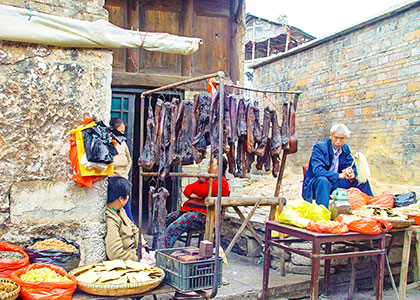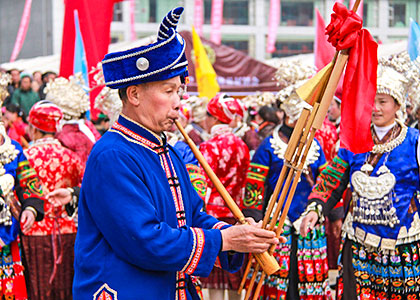Kaili Miao Ethnic Villages
4 Days Guiyang - Kaili (Miao Ethnic Villages) - Guiyang
Tour Type: Private tour; any parts of the itinerary can be customized
Guide: Private English-speaking tour guide
Transportation: Private air-conditioned car with experienced driver
Accommodation: Handpicked 4-star comfort hotels
Meals: 3 western buffet breakfasts, 1 lunch
Code: 801
Guide: Private English-speaking tour guide
Transportation: Private air-conditioned car with experienced driver
Accommodation: Handpicked 4-star comfort hotels
Meals: 3 western buffet breakfasts, 1 lunch
Code: 801
From USD559 per person Free Inquiry
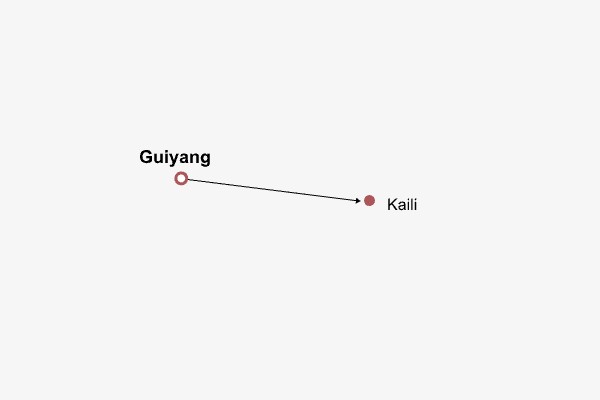
- Itinerary
- Prices
- Reviews
Trip Highlights
- Explore the famous stone-built Qingyan Ancient Town, encompassing city walls, age-old wooden houses, temples, and pavilions.
- Experience the unique “block-the-way” rice wine welcome ceremony and feel the Miao people’s hospitality.
- Get an insight into the traditional handmade paper-making techniques and Miao-style Batik art.
- Stroll through the local morning market and visit a Miao family to take in diversified folk customs.
Expand All
Collapse All
Day 1 Arrival in Guiyang
Sincere greetings & airport-hotel transfer. Qingyan Old Town if time allows.
Welcome to the Guiyang Kaili ethnic group tour! Upon arrival in Guiyang, the idyllic capital city of southwestern China’s Guizhou Province, our guide will greet you outside the baggage claim area of Guiyang Airport and escort you to the hotel for a rest.
If time permits, you’ll then be guided to Qingyan Ancient Town, located about 30 km (18.6 mi) from Guiyang city center and dubbed one of the four most famous ancient towns in Guizhou Province. With a history of around 600 years, the old town was first constructed in 1378 as a military fortification. ‘Qingyan’ means ‘green stone’ in Chinese, and quite literally, the town was made of local limestone to house armies and protect against attacks.
After arrival, you’ll first be amazed at its 2-km-long (1.2-mile) old city walls constructed on cliffs with four imposing city gates, which look like a small version of the Great Wall. The town has well preserved the original layout from the Ming and Qing Dynasties (1368-1911). Roaming through the narrow flagstone alleys, you’ll see hundreds of ancient residences, temples, shops, and theaters, most of which feature traditional double-eave hip-and-gable roofs and wooden doors with intricate flower carvings. The most iconic and historical alley in the town is called Secluded Street, which is made of various stones and lined with stone walls built with layers of shards. Walking on it, you’ll surely get a feel of stepping back in time. Shutterbugs cannot miss it! The ancient town also boasts being home to Guizhou’s first and only Zhuangyuan, the Number One Scholar in ancient China’s imperial examination. Today, you can find not only his old residence but also his once-favorite dish, Zhuangyuan Stewed Pig’s Feet. Besides, you can also try specialties like flavorful Qingyan rice tofu and rose sugar.
► Dining Recommendation: (at your own expense)
Jin Bi Xuan Restaurant is recommended for its wide choices of local snacks, delicious flavors, inviting atmosphere, and the affordable average cost of CNY 50 (USD 7). Stepping into it, you’ll see an open kitchen where the most authentic snacks are made, like savory Zhuangyuan Stewed Pig’s Feet, Rice Cake, and Ice Jelly. The restaurant also offers an open-air courtyard environment, surrounded by flowers and plants, full of vitality.
Accommodation: Holiday Inn Guiyang City Center (4 stars)
If time permits, you’ll then be guided to Qingyan Ancient Town, located about 30 km (18.6 mi) from Guiyang city center and dubbed one of the four most famous ancient towns in Guizhou Province. With a history of around 600 years, the old town was first constructed in 1378 as a military fortification. ‘Qingyan’ means ‘green stone’ in Chinese, and quite literally, the town was made of local limestone to house armies and protect against attacks.
After arrival, you’ll first be amazed at its 2-km-long (1.2-mile) old city walls constructed on cliffs with four imposing city gates, which look like a small version of the Great Wall. The town has well preserved the original layout from the Ming and Qing Dynasties (1368-1911). Roaming through the narrow flagstone alleys, you’ll see hundreds of ancient residences, temples, shops, and theaters, most of which feature traditional double-eave hip-and-gable roofs and wooden doors with intricate flower carvings. The most iconic and historical alley in the town is called Secluded Street, which is made of various stones and lined with stone walls built with layers of shards. Walking on it, you’ll surely get a feel of stepping back in time. Shutterbugs cannot miss it! The ancient town also boasts being home to Guizhou’s first and only Zhuangyuan, the Number One Scholar in ancient China’s imperial examination. Today, you can find not only his old residence but also his once-favorite dish, Zhuangyuan Stewed Pig’s Feet. Besides, you can also try specialties like flavorful Qingyan rice tofu and rose sugar.
► Dining Recommendation: (at your own expense)
Jin Bi Xuan Restaurant is recommended for its wide choices of local snacks, delicious flavors, inviting atmosphere, and the affordable average cost of CNY 50 (USD 7). Stepping into it, you’ll see an open kitchen where the most authentic snacks are made, like savory Zhuangyuan Stewed Pig’s Feet, Rice Cake, and Ice Jelly. The restaurant also offers an open-air courtyard environment, surrounded by flowers and plants, full of vitality.
Accommodation: Holiday Inn Guiyang City Center (4 stars)
Day 2 Guiyang - Kaili (Miao Ethnic Minority Villages)
Guiyang-Kaili transfer, Qingman Short-skirt Miao Village, local family visit & homemade lunch, watch the traditional paper-making in Shiqiao Miao Village, Boji Miao Village. (B+L)
This morning, let’s depart from Guiyang for Kaili, a cultural hub and the ideal gateway to numerous Miao ethnic minority villages tucked away in remote mountain areas. Accompanied by your private guide, you’ll dive deep into the culture of the Miao ethnic group, enjoy their traditional architecture and beautiful costumes, and learn about their lifestyles.
The first stop will be Qingman Short-Skirt Miao Village, inhabited by about 300 households. It is so named because local Miao women in the village wear short skirts all year round. Upon arrival, you’ll be warmly greeted by hospitable Miao villagers and then soak up the village’s old charm, combining the traditional Miao customs and long-standing farming civilization. The 600-year-old village keeps well its original look with simplicity. Traditional wooden stilted houses just nestle on the hillside or at the foot of the hill, connected by primitive flagstone paths. Local Miao people in traditional costumes and silver headdresses live a simple life, far away from the city’s hustle and bustle. Villagers here are also extremely good at exquisite crafts such as embroidery, weaving, and dyeing. We have especially arranged for you a local family visit so that you can get an insight into their daily life and enjoy a fantastic homemade lunch.
After lunch, we’ll head to Shiqiao Miao Village to see how paper is made in a traditional way. Originating from the mid-Tang Dynasty (roughly 755-845), the village’s traditional handmade paper making has a history of over 1,000 years, which makes full use of local barks, fir roots, and clear spring water as raw materials. You’ll be amazed at its total of 13 steps, without any modern technology.
The last stop of today is a long-skirt Miao village, Boji Miao Village, where over 100 Miao households have lived for generations, and it is renowned for its bucolic scenery. Boji means bamboo winnowing basket dustpan in Chinese, and the village is named for its shape like a half-basket dustpan. Surrounded by green rice fields on three sides, the village welcomes visitors with its stilted buildings and tranquil atmosphere. However, if you happen to run into a local festival, the whole village bursts out with joy, singing and dancing, along with their stools being tapped happily. After the visit, you’ll be escorted back to Kaili for hotel check-in.
Meals: Western buffet breakfast, Lunch
Accommodation: Banshan Hotel (Wanda Plaza in Kaili City Center) (4 stars)

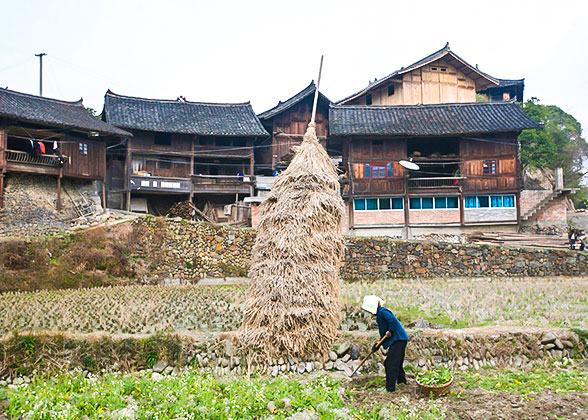
The first stop will be Qingman Short-Skirt Miao Village, inhabited by about 300 households. It is so named because local Miao women in the village wear short skirts all year round. Upon arrival, you’ll be warmly greeted by hospitable Miao villagers and then soak up the village’s old charm, combining the traditional Miao customs and long-standing farming civilization. The 600-year-old village keeps well its original look with simplicity. Traditional wooden stilted houses just nestle on the hillside or at the foot of the hill, connected by primitive flagstone paths. Local Miao people in traditional costumes and silver headdresses live a simple life, far away from the city’s hustle and bustle. Villagers here are also extremely good at exquisite crafts such as embroidery, weaving, and dyeing. We have especially arranged for you a local family visit so that you can get an insight into their daily life and enjoy a fantastic homemade lunch.
After lunch, we’ll head to Shiqiao Miao Village to see how paper is made in a traditional way. Originating from the mid-Tang Dynasty (roughly 755-845), the village’s traditional handmade paper making has a history of over 1,000 years, which makes full use of local barks, fir roots, and clear spring water as raw materials. You’ll be amazed at its total of 13 steps, without any modern technology.
The last stop of today is a long-skirt Miao village, Boji Miao Village, where over 100 Miao households have lived for generations, and it is renowned for its bucolic scenery. Boji means bamboo winnowing basket dustpan in Chinese, and the village is named for its shape like a half-basket dustpan. Surrounded by green rice fields on three sides, the village welcomes visitors with its stilted buildings and tranquil atmosphere. However, if you happen to run into a local festival, the whole village bursts out with joy, singing and dancing, along with their stools being tapped happily. After the visit, you’ll be escorted back to Kaili for hotel check-in.
Meals: Western buffet breakfast, Lunch
Accommodation: Banshan Hotel (Wanda Plaza in Kaili City Center) (4 stars)

Traditional Paper-making in Shiqiao Miao Village

Wooden Stilted Houses of Miao People
Day 3 Kaili (Miao Ethnic Minority Villages)
Local market, try the Batik art in Matang Gejia Village, Jidao Miao Village, Langde Miao Village with the "block-the-way" rice wine ceremony & Song and Dance Performance. (B)
Your private tour of the Miao ethnic minority continues today. After breakfast, we’ll visit a local morning market featuring Miao-style handicrafts, woodwork, bamboo baskets, and exquisite embroideries. Strolling around, you can also see red-orange persimmons, adorable round pumpkins, and green vegetables lined up along the narrow street, where you may even witness live chickens and fresh fish. If you happen to meet the livelier and more bustling Sunday Market, you’ll not only have a chance to splurge on a lot of local snacks but also glimpse an exciting cockfight.
After that, we’ll drive for about 30 minutes to Matang Gejia Village. Remaining one of the unidentified ethnic groups in China, it is often classified as a branch of the Miao ethnic group, though they stick to their own identity because they have totally different languages, cultures, and costumes from those of the Miao group. The villagers believe that they are descendants of Hou Yi, a mythological god who once shot down nine suns with an arrow, leaving only one in the sky, according to the Chinese legend. Today, the villagers still worship the sun, red bows, and white arrows, and keep archery traditions well. You’ll be accompanied to delve deep into the culture and admire the unique wooden houses. Besides that, another draw of the village is its batik art, which refers to applying melted wax and natural plant dyestuffs to create colorful fabric patterns on the clothes. Gejia Village doesn’t have its own characters, but those patterns are symbols showcasing its unique culture, telling its origin and mysterious past.
Then, we’ll proceed to Jidao Miao Village, nestling under a mountain and near a river. No wonder the village is called Jidao, meaning ‘a deep pool’ in the Miao language. This is a remote village where few visitors have set foot and thus it has preserved pure primitive lifestyles, and the bluestone roads are lined with old residences. You can hardly even find any shops or restaurants here.
Next, drive further south to the famous Langde Miao Village. Surrounded by mountains and rivers, it boasts wooden stilt houses, winding mountain paths, and a well-preserved Wind and Rain Bridge. What makes it so special among a lot of Miao villages is its unique greeting ceremony, and you’ll be welcomed by a twelve-course “block-the-way” rice wine set, which revolves around the highest hospitality etiquette of the local people. At each pass, two Miao girls in traditional costumes offer a toast to guests from afar, with clay bowls in the mid-passes and horn-shaped cups at the beginning and end of the passes, symbolizing happiness and longevity. Meanwhile, they will sing local folk songs to express their hospitality. After that, we will enter the village to enjoy a featured Song and Dance Performance by local villagers.
Meals: Western buffet breakfast
Accommodation: Banshan Hotel (Wanda Plaza in Kaili City Center) (4 stars)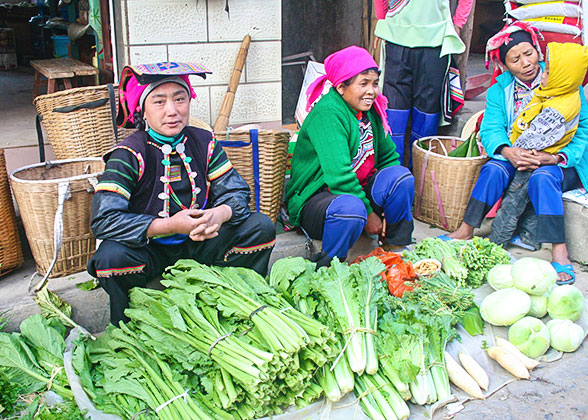
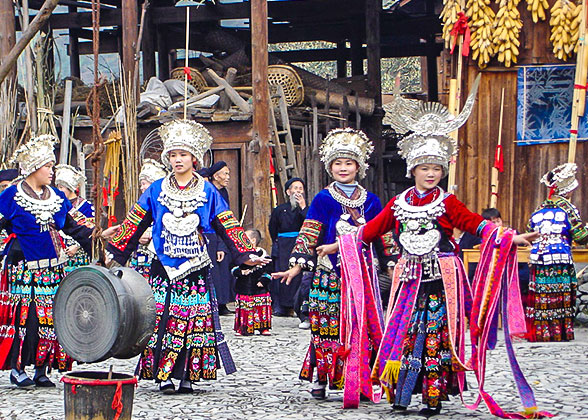
After that, we’ll drive for about 30 minutes to Matang Gejia Village. Remaining one of the unidentified ethnic groups in China, it is often classified as a branch of the Miao ethnic group, though they stick to their own identity because they have totally different languages, cultures, and costumes from those of the Miao group. The villagers believe that they are descendants of Hou Yi, a mythological god who once shot down nine suns with an arrow, leaving only one in the sky, according to the Chinese legend. Today, the villagers still worship the sun, red bows, and white arrows, and keep archery traditions well. You’ll be accompanied to delve deep into the culture and admire the unique wooden houses. Besides that, another draw of the village is its batik art, which refers to applying melted wax and natural plant dyestuffs to create colorful fabric patterns on the clothes. Gejia Village doesn’t have its own characters, but those patterns are symbols showcasing its unique culture, telling its origin and mysterious past.
★ Special Experience: Try the Traditional Batik Art in Person!
Follow the guide to step into one of the local batik art workshops; nearly every household here has its own workshop, and today you’ll follow a local master to learn how beautiful batik patterns come to life. First, choose your desired motif, and outline it with a pencil on a white cloth. Then dip the melted beeswax with a copper knife and trace the pattern following the pencil line drawing. Finish that and wash the cloth in indigo water dyed with pure plant. The last step is boiling the dyed fabric in hot water to melt the wax and letting it dry. Finally, you’ll get the stunning intricate fabric.Then, we’ll proceed to Jidao Miao Village, nestling under a mountain and near a river. No wonder the village is called Jidao, meaning ‘a deep pool’ in the Miao language. This is a remote village where few visitors have set foot and thus it has preserved pure primitive lifestyles, and the bluestone roads are lined with old residences. You can hardly even find any shops or restaurants here.
Next, drive further south to the famous Langde Miao Village. Surrounded by mountains and rivers, it boasts wooden stilt houses, winding mountain paths, and a well-preserved Wind and Rain Bridge. What makes it so special among a lot of Miao villages is its unique greeting ceremony, and you’ll be welcomed by a twelve-course “block-the-way” rice wine set, which revolves around the highest hospitality etiquette of the local people. At each pass, two Miao girls in traditional costumes offer a toast to guests from afar, with clay bowls in the mid-passes and horn-shaped cups at the beginning and end of the passes, symbolizing happiness and longevity. Meanwhile, they will sing local folk songs to express their hospitality. After that, we will enter the village to enjoy a featured Song and Dance Performance by local villagers.
Meals: Western buffet breakfast
Accommodation: Banshan Hotel (Wanda Plaza in Kaili City Center) (4 stars)

Local Morning Market

Dancing Performance in Langde Miao Village
Day 4 Departure from Guiyang
Kaili to Guiyang airport transfer & see you off. Wish you a pleasant journey! (B)
Your Guiyang Kaili tour packages end today. After breakfast, we’ll escort you back to Guiyang for your return flight. Hope our service has provided you with a pleasant memory!
If you want to extend your Guizhou tour to more ethnic villages or natural treasures like spectacular waterfalls, karst peaks and caves, or rice terraces, contact your travel consultant anytime to tailor your desired itinerary!
If you want to extend your Guizhou tour to more ethnic villages or natural treasures like spectacular waterfalls, karst peaks and caves, or rice terraces, contact your travel consultant anytime to tailor your desired itinerary!
Meals: Western buffet breakfast
Expand All
Collapse All
This trip can be customized to meet your individual needs!
Tour Prices
| 2-3 travelers | 4-5 travelers |
|---|---|
USD829 | USD559 |
- Prices are per person on twin sharing.
- If you are a group of 6 people or more, we will offer a more favorable price by your group size.
Price Includes
- Hotel accommodation with breakfasts
- Lunches as itinerary specifies
- Private English-speaking guides
- Private drivers & air-conditioned vehicles
- Entrance fees to tourist sites
Price Excludes
- Airfares of arrival and departure
- Entry visa fees
- Personal expenses
- Tips or gratuities for guides and drivers
Itineraries you may also like:


